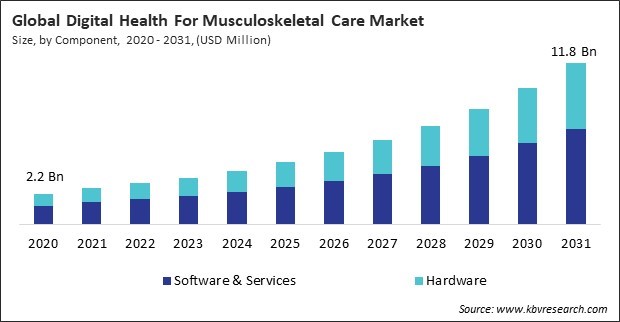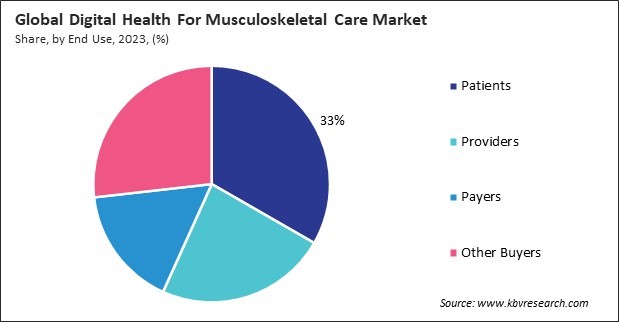“Global Digital Health For Musculoskeletal Care Market to reach a market value of 11.8 Billion by 2031 growing at a CAGR of 17%”
The Global Digital Health For Musculoskeletal Care Market size is expected to reach $11.8 billion by 2031, rising at a market growth of 17.0% CAGR during the forecast period.
The Europe segment garnered 33% revenue share in the digital health for musculoskeletal care market in 2023. Countries like Germany, the U.K., and France are responsible for adopting digital health solutions, particularly remote patient monitoring and virtual rehabilitation for MSK conditions. Europe’s focus on personalized medicine, combined with strong government support for digital health initiatives, has fueled the growth of this market.

Musculoskeletal (MSK) disorders, which include conditions like arthritis, lower back pain, and osteoporosis, are among the leading causes of disability worldwide. According to the Global Burden of Disease (GBD) 2019 data, approximately 1.71 billion individuals worldwide are affected by musculoskeletal conditions, which include osteoarthritis, amputation, rheumatoid arthritis, fractures, low back pain, and neck pain. Although the prevalence of musculoskeletal conditions differs by age and diagnosis, individuals of all ages worldwide are affected. Hence, the rising incidence of musculoskeletal issues will aid in the market's growth.
Additionally, Telemedicine has significantly transformed musculoskeletal (MSK) care by offering remote consultations, personalized rehabilitation programs, and continuous monitoring. Patients can access care from the convenience of their homes through digital platforms, which reduces the necessity for frequent in-person visits. These platforms often integrate wearable devices and mobile apps to track patient progress, allowing healthcare providers to make real-time adjustments to care plans. Thus, the growth of telemedicine will aid in the market's growth.
Significant challenges arise when implementing digital health solutions for musculoskeletal (MSK) care, including data privacy and security concerns. These platforms rely heavily on personal health information (PHI), making them prime targets for cyberattacks, data breaches, and unauthorized access. The increasing use of digital platforms introduces vulnerabilities that can compromise sensitive patient information. MSK care often involves real-time data for treatment and monitoring, so any data breach could negatively affect patient outcomes. Hence, these factors may hamper the growth of the market.
The COVID-19 pandemic initially caused significant musculoskeletal (MSK) care disruptions, as many traditional in-person services like physical therapy and orthopedic consultations were postponed. Patients with chronic MSK conditions were particularly affected, as delays in care led to worsened symptoms. Additionally, the rapid shift to digital platforms was challenging for healthcare systems not fully equipped to implement telehealth solutions. For many patients, especially older adults, navigating digital health tools proved difficult, highlighting disparities in access to digital healthcare during the pandemic. Thus, the pandemic had an overall negative impact on the market.
On the basis of end use, the digital health for musculoskeletal care market is classified into patients, providers, payers, and others. The providers segment recorded 23% revenue share in the digital health for musculoskeletal care market in 2023. Providers, including physicians, physical therapists, and orthopedic specialists, increasingly utilize digital platforms to deliver remote care, monitor patient progress, and improve treatment outcomes.

Based on component, the digital health for musculoskeletal care market is bifurcated into hardware and software & services. The hardware segment garnered 39% revenue share in the digital health for musculoskeletal care market in 2023. The segment's growth is largely due to the increasing adoption of wearable devices, sensors, and other monitoring tools that track patient mobility, posture, and recovery progress. These devices are essential for enabling remote monitoring and virtual rehabilitation, which became especially critical during the COVID-19 pandemic.
Free Valuable Insights: Global Digital Health For Musculoskeletal Care Market size to reach USD 11.8 Billion by 2031
Region-wise, the digital health for musculoskeletal care market is analyzed across North America, Europe, Asia Pacific, and LAMEA. The North America segment witnessed a 39% revenue share in the digital health for musculoskeletal care market in 2023. This dominance is largely driven by advanced healthcare infrastructure, high adoption rates of digital health technologies, and increasing demand for remote monitoring and telehealth services.
| Report Attribute | Details |
|---|---|
| Market size value in 2023 | USD 3.4 Billion |
| Market size forecast in 2031 | USD 11.8 Billion |
| Base Year | 2023 |
| Historical Period | 2020 to 2022 |
| Forecast Period | 2024 to 2031 |
| Revenue Growth Rate | CAGR of 17.0% from 2024 to 2031 |
| Number of Pages | 181 |
| Tables | 260 |
| Report coverage | Market Trends, Revenue Estimation and Forecast, Segmentation Analysis, Regional and Country Breakdown, Porter’s 5 Forces Analysis, Company Profiling, Companies Strategic Developments, SWOT Analysis, Winning Imperatives |
| Segments covered | Component, End Use, Region |
| Country scope |
|
| Companies Included | Hinge Health, Inc., Sword Health, Inc., Omada Health, Inc., Kaia Health Software, Inc., DarioHealth Corp., IncludeHealth Inc., SimpleTherapy, Inc., Exer Labs, Inc., Force Therapeutics LLC, and Vori Health, Inc. |
By Component
By End Use
By Geography
This Market size is expected to reach $11.8 billion by 2031.
Increasing Prevalence Of Musculoskeletal Disorders are driving the Market in coming years, however, Data Privacy And Security Concerns restraints the growth of the Market.
Hinge Health, Inc., Sword Health, Inc., Omada Health, Inc., Kaia Health Software, Inc., DarioHealth Corp., IncludeHealth Inc., SimpleTherapy, Inc., Exer Labs, Inc., Force Therapeutics LLC, and Vori Health, Inc.
The expected CAGR of this Market is 17.0% from 2024 to 2031.
The Software & Services segment captured the maximum revenue in the Market by Component in 2023, thereby, achieving a market value of $7.0 billion by 2031.
The North America region dominated the Market by Region in 2023, and would continue to be a dominant market till 2031; thereby, achieving a market value of $4.4 billion by 2031.
Our team of dedicated experts can provide you with attractive expansion opportunities for your business.

 Drivers
Drivers
 Restraints
Restraints
 Opportunities
Opportunities
 Challenges
Challenges
